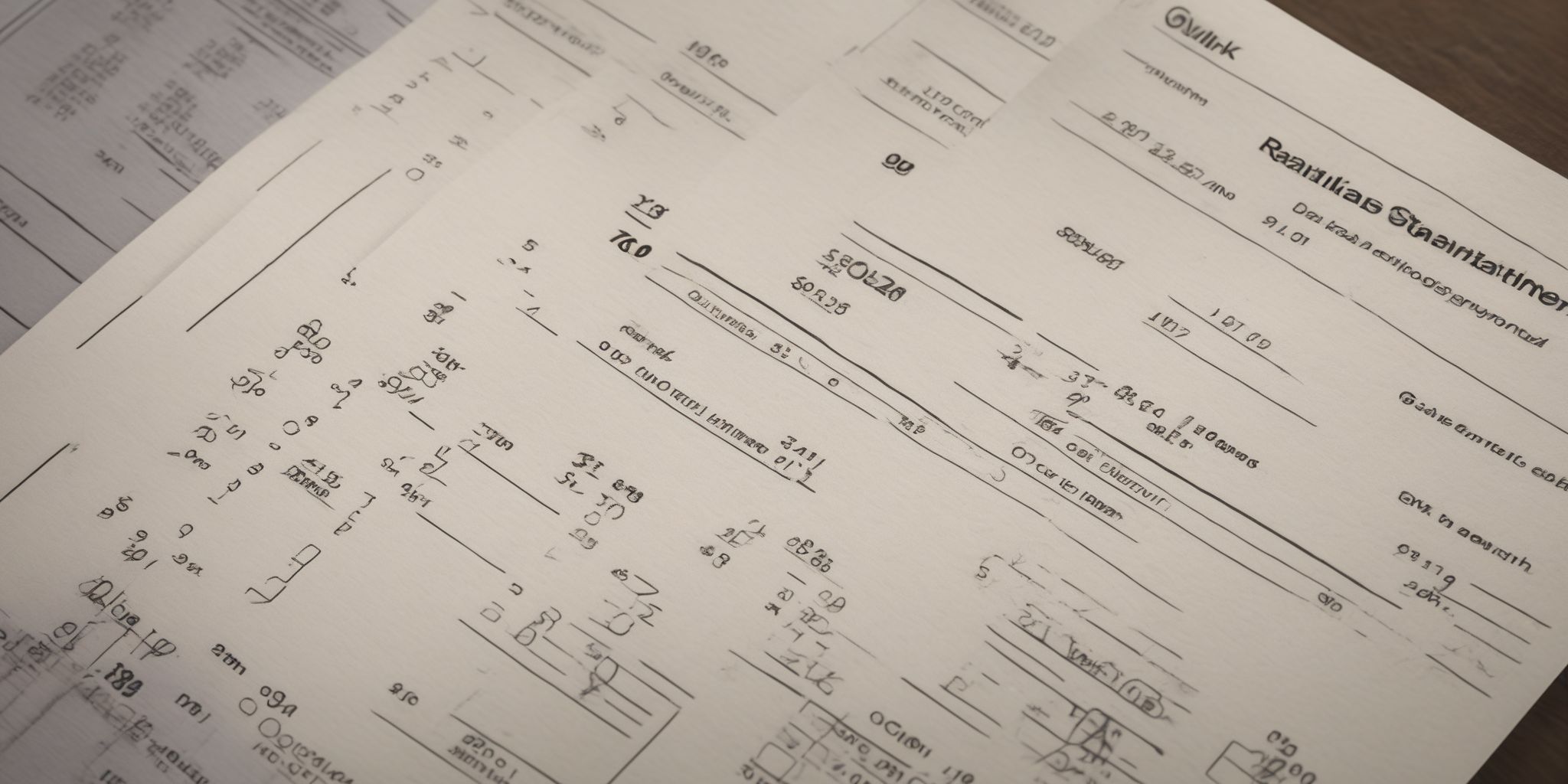Creating an Efficient Expenses Spreadsheet: Tips and Tricks
Tracking expenses can often be a tedious and overwhelming task. From jotting down every single purchase to organizing receipts, it's easy to feel like you're drowning in a sea of numbers. But what if there was a way to bring order to this chaos? Enter the expenses spreadsheet - a simple yet powerful tool that can transform your financial management game.
In this article, we'll unveil some practical tips and nifty tricks to help you create an efficient expenses spreadsheet that not only saves your sanity but also brings clarity to your financial journey. So grab your favorite beverage, sit back, and let's dive into the world of spreadsheet wizardry!
Understanding the Importance of an Expenses Spreadsheet
- A well-maintained expenses spreadsheet is vital for effective financial management.
- It provides a clear overview of your income, expenses, and overall financial health.
- Tracking and categorizing expenses in a spreadsheet helps identify spending patterns and areas for potential cost savings.
- It enables accurate budgeting and forecasting, helping businesses and individuals make informed financial decisions.
- An expenses spreadsheet ensures compliance with tax regulations and facilitates hassle-free audits.
- It also serves as a central repository for financial data, making it easier to analyze and generate reports for stakeholders.
Benefits of Creating an Efficient Expenses Spreadsheet
An efficient expenses spreadsheet offers several benefits.
Firstly, it provides a clear and organized overview of your financial transactions, allowing you to easily track and categorize expenses. This enables you to identify spending patterns, pinpoint areas of overspending, and make informed budgeting decisions.
Additionally, an efficient spreadsheet can save time and effort by automating calculations and generating reports, making it easier to analyze your financial data. Furthermore, having an accurate and up-to-date record of expenses can simplify tax preparation and help ensure compliance with financial regulations.
Getting Started
Choosing the Right Software or Tool
Choosing the right software or tool for your expenses spreadsheet is crucial. Look for a program that offers a user-friendly interface and robust features. Consider the compatibility with your operating system and devices.
Additionally, prioritize software that allows easy integration with other applications and provides cloud storage for secure access to your spreadsheet from anywhere. Look for options that offer customizable templates or the ability to create your own tailored layout.
Finally, read reviews and gather recommendations from trusted sources to ensure you select the best option that suits your specific needs.
Setting Up the Spreadsheet
- Start by creating a new spreadsheet in your preferred software.
- Define clear column headers such as "Date," "Description," "Category," "Amount," etc.
- Consider adding additional columns for payment method, vendor information, and any other relevant details.
- Structure the categories in a logical and organized manner, such as "Transportation," "Food," "Utilities," etc.
- Format the cells to ensure consistency and readability, using features like bolding, borders, and color-coding.
- Create a separate sheet to calculate totals and generate reports, linking it to the expense data sheet.
- Regularly review and update the formatting and structure of your spreadsheet to maintain its effectiveness.
Designing Columns and Categories
When designing columns and categories for your expenses spreadsheet, simplicity and clarity should be your guiding principles. Start by identifying the most relevant expense categories for your specific needs, such as travel, office supplies, or utilities. Keep these categories broad enough to cover all necessary expenses, yet specific enough to facilitate easy tracking and analysis.
Consider organizing your columns in a logical order that aligns with your expense categories. For example, you may choose to arrange columns in the order of date, description, category, amount, and payment method. This arrangement allows for quick and efficient data entry while enabling straightforward calculations and analysis.
Remember, the goal is to make your expenses spreadsheet intuitive and user-friendly, so anyone can easily understand and navigate it without confusion.
Formatting the Spreadsheet
Formatting the Expenses Spreadsheet is crucial for easy data management. Start by organizing your columns with clear labels, such as "Date," "Category," and "Amount." Use formatting features like bold and italics to distinguish headers and important information.
Additionally, apply conditional formatting to highlight expense thresholds or overdue payments. Consider color-coding categories to quickly identify spending patterns. Use cell borders effectively to create a neat and organized layout. Utilize formatting options specific to your spreadsheet software, like freezing panes or creating drop-down menus for consistent data entry. A well-formatted spreadsheet will enhance readability and streamline your expense tracking process.
Tracking Expenses
Recording Daily Expenses
Recording daily expenses is a fundamental aspect of managing an expenses spreadsheet. It allows you to accurately track and categorize your spending. Make it a habit to enter your expenses regularly, either at the end of each day or as they occur. Include all relevant details such as the date, vendor, description, and amount. By doing so, you can easily monitor your spending patterns and identify areas where you can make adjustments.
For example, if you notice that a significant portion of your expenses is going towards dining out, you can proactively budget for meals at home to save money.
Entering Expenses in Real-time
- Inputting expenses into the spreadsheet as they occur is a time-saving and accurate approach.
- Use a mobile app or cloud-based platform that syncs with your expenses spreadsheet for easy real-time input.
- Take advantage of OCR (optical character recognition) technology to automatically extract details from receipts and invoices.
- Attach digital copies of receipts or invoices to each expense entry for future reference.
- Assign relevant categories or tags to expenses immediately to streamline analysis and tracking.
- Regularly review and reconcile entries to ensure accuracy and identify any discrepancies promptly.
- By entering expenses in real-time, you can maintain an up-to-date and comprehensive overview of your financial records, helping you make informed decisions.
Automating Expense Tracking
Automating expense tracking in your expenses spreadsheet can significantly streamline your processes. By utilizing functions or macros, you can automatically import data from various sources, such as bank statements or credit card transactions. This eliminates the need for manual entry, reducing errors and saving time.
Additionally, setting up recurring expenses with automated reminders ensures you never miss a payment.
For example, you can create formulas that calculate monthly bills based on past data, automatically updating as new expenses are entered. Automation not only improves accuracy but also ensures you have an up-to-date view of your financials without spending hours manually inputting data.
Analyzing and Managing Expenses
Organizing Data with Filters and Formulas
- Filters can help streamline expense data by displaying specific categories or criteria, making it easier to analyze and manage.
- Use filters to quickly identify expenses within a specific date range, by vendor, or by expense type.
- Formulas are powerful tools for automating calculations and managing financial data.
- Implement formulas to calculate totals, averages, and percentages, saving time and reducing errors.
- Examples of formulas include SUM, AVERAGE, and COUNT, which can be applied to expense categories or specific cells within the spreadsheet.
- By organizing data efficiently with filters and formulas, you can gain valuable insights into spending patterns and make informed financial decisions.
Using Filters for Quick Analysis
Using filters in your expenses spreadsheet can greatly enhance your ability to analyze and make sense of your financial data. Filters allow you to quickly sort and view specific subsets of expenses based on criteria such as dates, categories, or amounts.
For example, you can filter to view all expenses in a particular month or all expenses related to a specific category like "office supplies." This enables you to identify spending patterns, cost outliers, or areas where you can potentially cut back. By utilizing filters, you can gain valuable insights and make data-driven decisions to optimize your budget and improve overall financial management.
Implementing Formulas for Calculations
Implementing formulas for calculations is a fundamental aspect of managing an expenses spreadsheet efficiently. Formulas allow you to automate calculations, saving time and reducing errors.
For example, you can use formulas to calculate totals, averages, or percentages in your spreadsheet. The SUM function adds up values in a range, while the AVERAGE function calculates the average of a set of numbers. By employing formulas like these, you can quickly analyze and understand your expenses.
Additionally, you can combine formulas with logical functions like IF or COUNTIF to perform more complex calculations or create conditional statements. Mastering formulas empowers you to derive meaningful insights from your expenses data effortlessly.
Creating Visualizations for Better Insights
Creating visualizations in your expenses spreadsheet can provide valuable insights into your financial data. By representing your expenses visually, you can quickly identify spending patterns, trends, and areas where you can cut costs or optimize your budget.
Utilize charts and graphs to present your data in a clear and intuitive format. For example, a bar chart can show the distribution of expenses across different categories, while a line graph can track changes in spending over time. This visual representation makes it easier to understand and analyze your financial situation at a glance.
Furthermore, consider generating reports that consolidate relevant information from your expenses spreadsheet. These reports can help you summarize your findings and present them to stakeholders or make strategic decisions.
Visualizations add a new layer of understanding to your expenses spreadsheet, making it easier to identify opportunities for improvement and make informed financial decisions.
Utilizing Charts and Graphs
Visualizing your expense data through charts and graphs can provide valuable insights and help identify spending patterns at a glance. Pie charts can represent the distribution of expenses across different categories, while bar charts can compare spending by month or year. Line graphs can show trends over time, enabling you to track overall expenses and identify any fluctuations. By analyzing these visual representations, you can quickly identify areas where you are overspending or where cost-saving measures have been effective. This allows you to make informed decisions and adjust your budget accordingly, improving overall financial management.
Generating Reports
Reports are a valuable tool in managing expenses and gaining valuable insights from your spreadsheet. By generating reports, you can easily analyze spending patterns, identify trends, and make informed financial decisions. Whether it's a summary of monthly expenses or a breakdown by categories, reports provide a clear overview of your financial situation. To generate reports efficiently, utilize features such as pivot tables, charts, and conditional formatting. These tools allow you to visualize data and present it in a format that is easy to interpret. Remember to customize your reports based on your specific needs and regularly update them to stay informed about your financial health.
Tips and Tricks for Efficiency
Utilizing Keyboard Shortcuts
Utilizing Keyboard Shortcuts: Boosting Efficiency in Your Expenses Spreadsheet
Keyboard shortcuts can greatly enhance your workflow when managing an expenses spreadsheet. Instead of relying solely on tedious mouse clicks, keyboard shortcuts allow you to navigate and perform tasks quickly.
For example, using Ctrl+C to copy a cell and Ctrl+V to paste it saves time and reduces repetitive actions. Similarly, pressing Ctrl+S to save your changes or Ctrl+Z to undo mistakes can help prevent data loss and errors. By learning and implementing essential keyboard shortcuts, such as Ctrl+A to select all cells or Ctrl+H to find and replace values, you can streamline your spreadsheet management process and work more efficiently.
Using Templates
- Templates can be incredibly helpful when creating an expenses spreadsheet, as they provide a pre-designed structure that can be customized to suit your specific needs.
- By using a template, you save time and effort in setting up the initial layout of the spreadsheet, allowing you to focus more on entering and analyzing your expenses.
- Templates often come with pre-built formulas and functions that automate calculations, making it easier to track your expenses accurately.
- Look for templates that include categories commonly used for expenses, such as transportation, meals, and office supplies.
- Free templates are widely available online, and they can be easily modified to fit your unique requirements.
Regularly Updating and Reviewing the Spreadsheet
Regularly updating and reviewing your expenses spreadsheet is vital for maintaining accuracy and optimizing your financial management. By updating it consistently, you ensure that all recent expenses are accounted for and prevent any overlooked or duplicated entries. Regular reviews allow you to identify patterns, spot areas for improvement, and make informed decisions.
For example, you might notice a particular category of expenses consistently exceeding your budget, prompting you to take action to reduce unnecessary costs. By dedicating time on a weekly or monthly basis to review and update your spreadsheet, you'll have a clearer understanding of your financial situation and be able to make proactive adjustments to meet your financial goals.
Over to you
Creating an efficient expenses spreadsheet can be a daunting task, but with a few tips and tricks, the process can become much simpler. The first step is to organize the spreadsheet by categorizing expenses, making it easier to track and analyze spending habits. Adding dates to each expense entry helps maintain a clear timeline, while including detailed descriptions provides clarity. Utilizing formulas and functions can automate calculations, saving time and reducing errors.
Formatting the spreadsheet with colors, fonts, and borders makes it visually appealing and easy to read. Regularly updating and reviewing the spreadsheet ensures accurate and up-to-date information.


